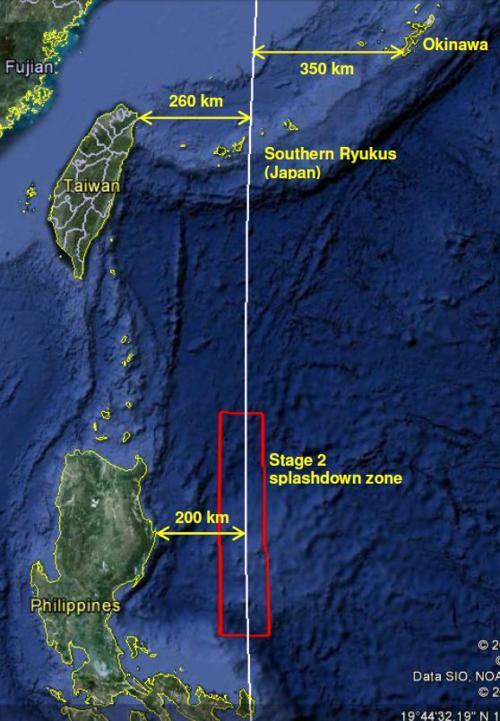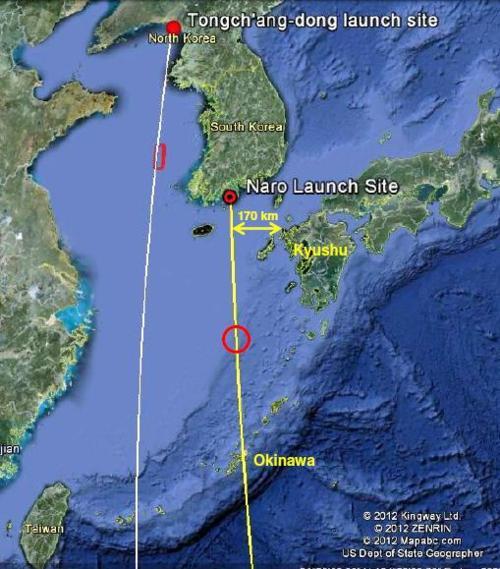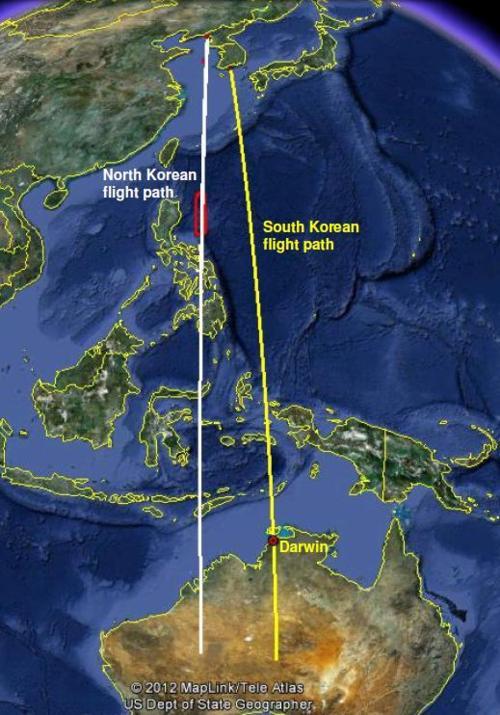 Figure 1. The early part of North Korea’s planned flight path.
Figure 1. The early part of North Korea’s planned flight path.
By launching south from its Tongch’dong launch site, North Korea can avoid flying over any large land areas early in flight. Its previous flights, which were launched from the Musudan site on its eastern shore, overflew Japan during the launcher’s boost phase.
But the southern path would carry it in a narrow corridor, as the maps below show. The white line in Figures 1 and 2 are the ground tracks of the trajectory based on the splashdown zones North Korea announced for the first two stages of the launcher. This has led to some discussion about how much risk the launch poses to nearby land areas. In the end, that depends on a lot of things, but here are a few thoughts about it.
In North Korea’s April 2009 launch, the rocket followed its intended path and the stages fell in the planned splashdown zones, demonstrating that North Korea has some ability to control the rocket’s trajectory. In that case, the third stage apparently did not ignite, and it and the satellite it carried fell into the second-stage splashdown zone.
The main question is what would happen if North Korea loses control of the rocket after launch so that it veers off its intended path. North Korea will be closely monitoring the launch. Since it is a liquid-fueled rocket the engines could be shut down quickly if launch engineers detect a problem, as long as the problem does not also cut off communication with rocket. The stages may also be equipped with self-destruct charges to try to break up large pieces before they fall to earth.
At launch the Unha rocket has a mass of 80 to 85 tons. Because of its mass, it accelerates relatively slowly for about two minutes, at which point the first stage burns out and separates from the upper stages. If all goes well, that stage would splash down in the red rectangle in Figure 1. If something goes wrong before that, the rocket would either be near North Korean territory or over the ocean west of South Korea. So this part of the launch would seem to pose relatively little threat to neighboring countries.
The first stage makes up about 80% of the mass of the launcher—roughly 65 tons—so once that stage is dropped only 20% of the original launcher mass is still under acceleration. As shown in Figures 1 and 2, the ground track of these upper stages would pass between South Korea and China, and then between Okinawa and Taiwan, and over the Southern Ryuku Islands, which are Japanese territory. At that point, if things are going as planned, the launcher would be at an altitude of several hundred kilometers. As with stage 1, if stage 2 started to veer off the intended path the engines could be shut down to keep it from gaining much lateral speed.

Figure 2. North Korea’s planned flight path and the announced second stage splashdown zone.
However, once the second stage burned out it would still travel for roughly 1,000 seconds on an arc through space before splashing down. If the direction the stage was traveling at burnout was misaligned laterally by a few degrees, that could cause the stage to travel sideways from the intended trajectory and fall to earth a couple hundred kilometers to the side of the stage 2 splashdown zone. As Figure 2 shows, that would be enough to potentially cause the stage to hit the Philippines. The second stage without its fuel would have a mass of roughly 1.5 metric tons; it could break up or partially burn up as it reentered the atmosphere.
If the third stage works as planned it would reach orbital speed and both it and the satellite would remain in orbit. Figure 3 shows the ground track of the path they would follow, which would carry them over islands of the Philippines and Indonesia, and Australia. If there was a problem relatively early in the operation of the third stage it might only speed up slightly and could fall in this region. Otherwise it would pass over these areas at an altitude of about 500 km.

Figure 3. North Korea’s planned flight path.
Comparison with South Korean Launches
South Korea has had two unsuccessful satellite launches, on August 25, 2009 and June 10, 2010, and it’s interesting to compare these launches with North Korea’s planned launch. While people argue that the unreliability of North Korean technology is what creates the risks, the South Korean launches had problems of their own.
South Korea’s KSLV-1 is a 2-stage, 140-ton launcher that uses a Russian-built liquid-fueled first stage and a domestically built solid-fueled second stage. Launched from its Naro site, the rocket travels south on a path similar to that planned for the North Korean launch. Figures 4 and 5 show the approximate path. Early in flight it would pass less than 200 km from the large Japanese island of Kyushu and less than 100 km from Fukue Island west of Kyushu. The trajectory would then carry it over Okinawa, and then over Australia and the islands north of it.

Figure 4. The yellow path on the right is the approximate ground track that South Korea’s launches followed. The red circle shows the location where debris from the 2010 South Korean launch is reported to have been found.

Figure 5. Comparison of North Korean (white) and South Korean (yellow) launch paths.
The early part of South Korea’s 2009 launch apparently went as planned. But problems releasing the faring that covers the satellite caused the launcher to go out of control while the second stage engines were burning, and it tumbled back to earth. A piece of debris believed to be from the second stage engine landed in Australia, near Darwin (Figure 5).
During the 2010 launch, the operators lost communication with the launcher about two minutes into flight when it was at an altitude of about 70 km, and it is thought to have exploded. The cause is still not known. The South Korean navy reportedly found debris from the launch 470 km south of the launch site (see Figure 4).
South Korea is planning a third launch attempt by October of this year. Since one theory is that the explosion of the previous launch may have been related to the self-destruct explosives on the second stage, South Korea said last December that it would remove these explosives for the next launch. The lack of this safety system could cause concerns if there are again problems with the launch.
Previous post on North Korea. Next post.
